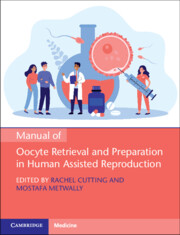Book contents
- Manual of Oocyte Retrieval and Preparation in Human Assisted Reproduction
- Manual of Oocyte Retrieval and Preparation in Human Assisted Reproduction
- Copyright page
- Contents
- Contributors
- Chapter 1 The Ovary: A General Overview of Follicle Formation and Development
- Chapter 2 Monitoring of Ovarian Stimulation
- Chapter 3 Theatre Design, Equipment and Consumables for Oocyte Retrieval
- Chapter 4 Conscious Sedation and Analgesia for Oocyte Retrieval
- Chapter 5 Practical Clinical Aspects of Oocyte Retrieval
- Chapter 6 Challenges during Oocyte Retrieval
- Chapter 7 Complications of Oocyte Retrieval
- Chapter 8 The Nurse’s Role during Oocyte Retrieval
- Chapter 9 Laboratory Design, Equipment and Consumables for Oocyte Retrieval
- Chapter 10 Quality Management Requirements for Oocyte Collection
- Chapter 11 Morphological Assessment of Oocyte Quality
- Chapter 12 Oocyte Preparation for Conventional In Vitro Fertilisation and Intracytoplasmic Sperm Injection
- Chapter 13 Oocyte Retrieval: The Patient’s Perspective
- Index
- Plate Section (PDF Only)
- References
Chapter 4 - Conscious Sedation and Analgesia for Oocyte Retrieval
Published online by Cambridge University Press: 09 November 2022
- Manual of Oocyte Retrieval and Preparation in Human Assisted Reproduction
- Manual of Oocyte Retrieval and Preparation in Human Assisted Reproduction
- Copyright page
- Contents
- Contributors
- Chapter 1 The Ovary: A General Overview of Follicle Formation and Development
- Chapter 2 Monitoring of Ovarian Stimulation
- Chapter 3 Theatre Design, Equipment and Consumables for Oocyte Retrieval
- Chapter 4 Conscious Sedation and Analgesia for Oocyte Retrieval
- Chapter 5 Practical Clinical Aspects of Oocyte Retrieval
- Chapter 6 Challenges during Oocyte Retrieval
- Chapter 7 Complications of Oocyte Retrieval
- Chapter 8 The Nurse’s Role during Oocyte Retrieval
- Chapter 9 Laboratory Design, Equipment and Consumables for Oocyte Retrieval
- Chapter 10 Quality Management Requirements for Oocyte Collection
- Chapter 11 Morphological Assessment of Oocyte Quality
- Chapter 12 Oocyte Preparation for Conventional In Vitro Fertilisation and Intracytoplasmic Sperm Injection
- Chapter 13 Oocyte Retrieval: The Patient’s Perspective
- Index
- Plate Section (PDF Only)
- References
Summary
Oocyte retrieval is a necessary part of IVF treatment. Conscious sedation using a combination of midazolam for anxiolysis, propofol for sedation and alfentanil for analgesia is the commonest approach used to provide pain relief for oocyte retrieval. This chapter presents a practical overview of patient sedation for assisted conception. Recommendations are based on the framework for safe sedation practice set out by the Royal College of Anaesthetists (UK) and include pre-operative assessment, patient preparation and fasting, sedation and analgesia medication, monitoring and recovery. While conscious sedation is commonly delivered by medical practitioners, nurse-led sedation is increasingly being adopted in the fertility sector as it is both appropriate and safe with certain caveats. We also describe the development of a nurse-led sedation service within a hospital-based fertility clinic (Ninewells Assisted Conception Unit, NHS Tayside, UK), and include examples of documentation (pre-anaesthetic chart) and drug protocols developed for effective and safe practice.
- Type
- Chapter
- Information
- Publisher: Cambridge University PressPrint publication year: 2022

